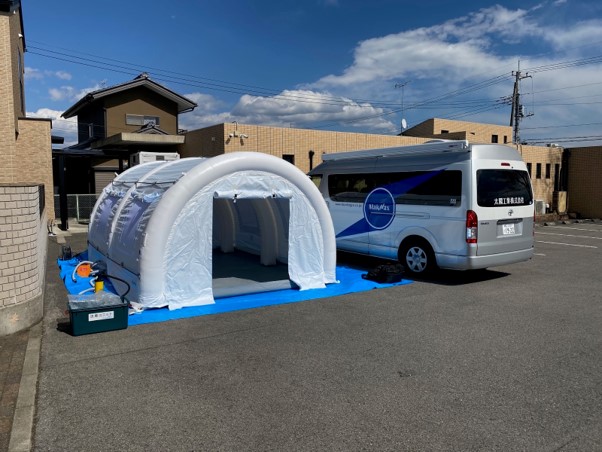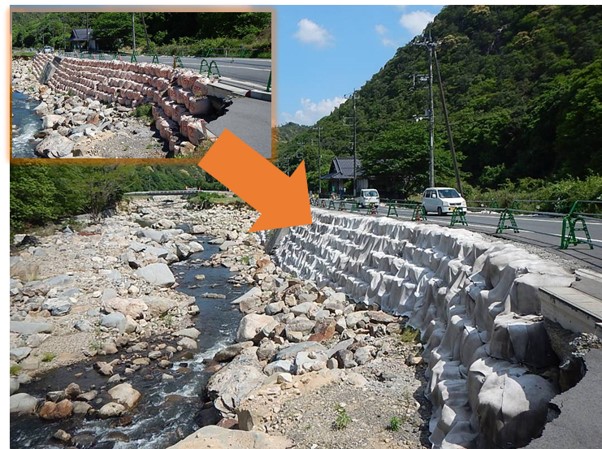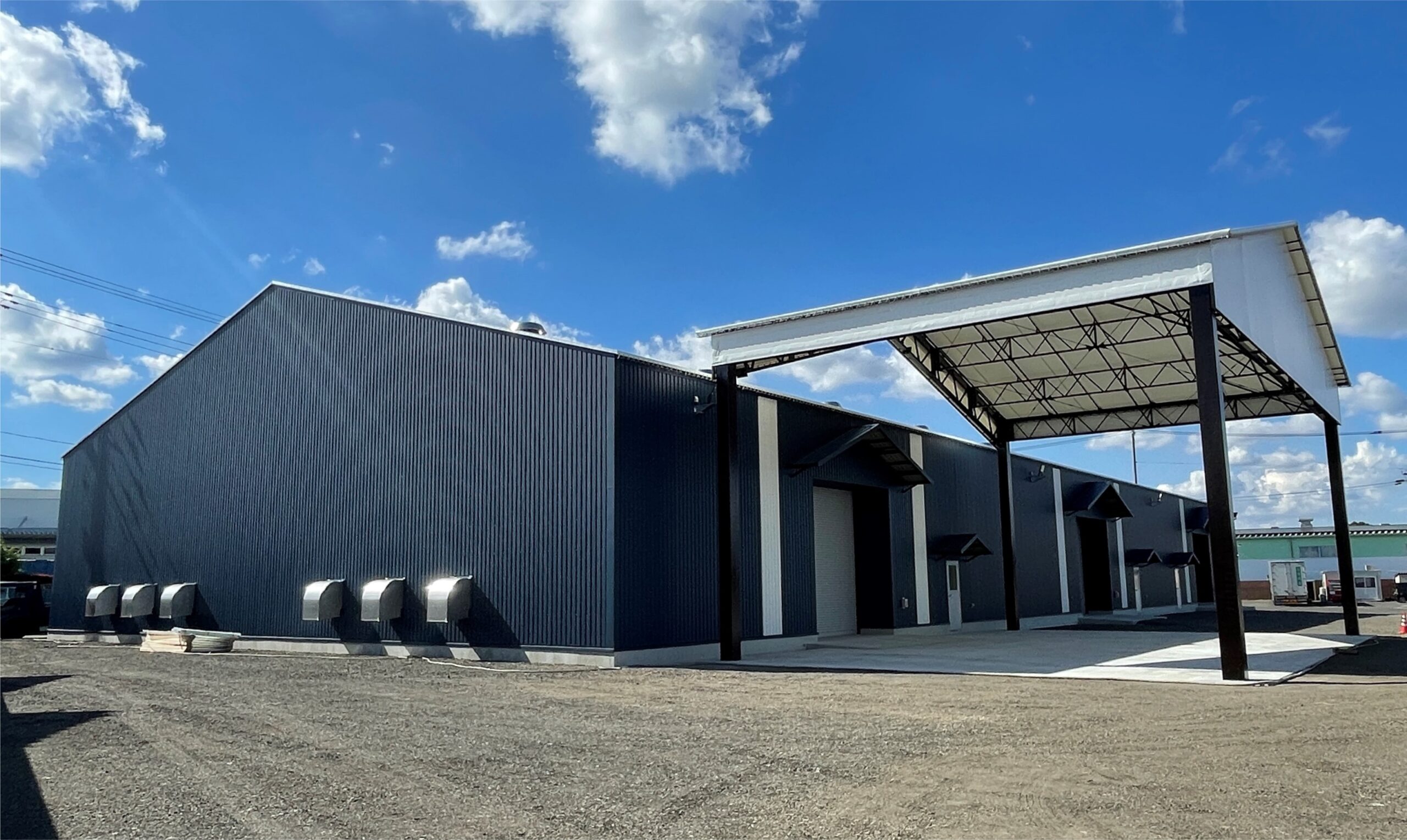

Taiyo Kogyo Column
Prevention of nosocomial infection by tent for outpatients with fever [Case study of response to new coronavirus].
2020.04.30

In 2020, the ferocious spread of the new coronavirus will require a different level of awareness in the medical field.
In particular, PCR testing for new coronaviruses and medical clinics are key to preventing overshoots (explosive patient surges) and medical collapses caused by new coronaviruses, and as a safer solution, we propose the use of air tents as temporary medical facilities.
We will introduce in detail why medical air tents are best suited for fever outpatient consultations and drive-through examination stations, including case studies.
 Example from Korea: Emergency special clinic “screening clinic”
Example from Korea: Emergency special clinic “screening clinic”
 Example from Korea: Drive-through PCR testing
Example from Korea: Drive-through PCR testing
Issues with the current inspection system
We believe that the current inspection system has two issues: inspection capacity and infection risk. As of April 2020, Japan has the capacity to test approximately 18,000 cases per day, but only about 15,000 cases are actually tested. In addition, saliva-based testing and blood-based antibody testing are attracting increasing attention.

Since the implementation of PCR testing requires a lot of time and effort from healthcare professionals, if all of these tests are handled, it may lead to a collapse of healthcare because not enough resources can be allocated to other medical operations. Therefore, control by health centers is needed. In addition to resource problems, if people suspected of being infected rush into a limited space within a medical facility, there is a risk of nosocomial infection spreading to healthcare workers and other users at that site. In PCR testing for novel coronavirus, a swab is inserted into the examinee’s nose to collect a specimen. During the test, the healthcare worker wears protective clothing called PPE (personal protective equipment). During the test, as well as before and after the test, the healthcare worker needs a dedicated space to put on and take off the PPE in order to avoid contact with the surrounding environment. In addition, materials, equipment, and spaces that may be exposed to viruses during testing are subject to disinfection. In order to efficiently conduct thorough disinfection, it is necessary to limit the disinfection work area, which must be completely separated from the conventional flow lines of facility users. To begin with, conducting inspection/disinfection in a hospital with limited space increases the risk of spreading secondary infections such as so-called nosocomial infections and clusters. Establishment of a temporary facility will provide a sense of security to residents living near the facility and to the general patient population visiting the hospital.
Efficient temporary temporary inspection station temporary installation │ What performance is required there?
上記のリスクを抑えるには、病院などの医療施設の外に、独立した仮設の検査所を設ける方法が求められています。
レッカー展張テント
そして、新型コロナウイルスのように大規模な感染拡大を起こす感染症の仮設検査所においては、以下の機能が必要になります。
Compact and easy to store in normal times
Temporary inspection stations must be compact enough to be stored out of place during normal times and quickly retrieved in an emergency.
Easy to carry
Temporary laboratories should not be limited in location during an emergency. Therefore, it must be easily portable. Each set should be lightweight and compact enough to be carried by two adults.
Easy to handle
Since it must be deployed quickly in an emergency, it must be something that can be handled without specialized knowledge or skills. It is not appropriate if it is complicated to set up or if it is difficult to set up without familiarity.
Can be installed by a small number of people
One of the purposes of temporary laboratories is to reduce personnel costs in the medical field. If it takes a lot of manpower to set up the laboratory, it will be a disaster. The laboratory must be capable of being set up by a small number of people.
Can be installed in a short time
As emergency equipment, anything that takes a long time to install is undesirable. It must be able to be deployed in a few minutes in an emergency.
Easy and quick removal
The ability to withdraw as quickly as possible without spending resources and costs is required.
Medical air tents to realize emergency special medical clinics
The medical air tent implements the functions required for temporary laboratories as described above, and is also effective as a drive-through laboratory.
What is an air tent?
This is a quick-response tent that is formed by inflating with air, instead of a conventional tent that uses a pipe framework. It can be set up quickly, by anyone, and easily in an emergency, and has a full range of functions for creating a work space.
Taiyo Kogyo’s “McQuick Shelter” air tent for medical use
The McQuick Shelter from Taiyo Kogyo, a long-established tent manufacturer, retains the following features Ideally effective as an emergency special clinic (screening click).
Compact and easy to store
The McQuick Shelter medical air tent has no framework and is composed entirely of fabric, making it compact and easy to store. The McQuick Shelter takes up little space and does not overwhelm the storage of other equipment, as it can be folded up to make room on top of the tent. You won’t have trouble taking it out.
Lightweight and easy to carry
The McQuick Shelter medical air tent is so lightweight that it can be carried by just two people. It can also be folded down to a size that can be loaded into a passenger car, making it extremely easy to transport.
Compared to conventional air tents, the McQuick Shelter has fewer air columns, making it easier to fold and significantly lighter. (*Aerial column is the part of the tent that is filled with air to support it. The fabric is also made of fiber instead of rubber, making it even lighter.)
Easy to install, just unfold and inflate.
The folded air tent is unfolded at the set-up location, and air is pumped in manually or with a pump to complete the installation. Since there is no manual labor, even women can handle it easily. No specialized knowledge or familiarity is required.
Can be set up by just two people
The McQuick Shelter medical air tent can be deployed by two adults per set. As shown in the photo below, you only need to wait for it to inflate with air, so it can be set up with only the personnel supporting both ends.
Can be installed in as little as 3 minutes
The time required to set up a McQuick shelter is as follows and can be completed in as little as 3 minutes.
- Unfolding the folded tent (1-2 minutes)
- Installing the rods (1-2 minutes)
- Air filling (1-3 minutes) *can be done manually
Since air filling can be done manually, it can also be used when a power source (generator) for an air pump is not available. Even manual filling can be done in about 10 minutes.
Fire-resistant material used to resist fire and strong winds
The tent fabric is made of fire-retardant material and is designed to resist the spread of fire. It also has excellent shape stability and can be used safely even in strong winds.
Independent air column and dual tube construction allows on-site repair
In a typical air tent, the air columns are all connected, so if a hole is made in one part, air leaks out and the whole tent collapses, requiring transportation to a specialized factory for repair. On the other hand, McQuick shelters have independent air columns, reducing the risk of complete collapse.
The double-layered construction of the air columns prevents damage from reaching the inside and allows for on-site replacement work to be restored without having to replace the entire tent.
Can be removed in just 5 minutes
Removal of the McQuick shelter is also easy and quick. The air is released by simply pressing the exhaust button, so there is no need to manually apply pressure, and removal is generally completed after a five-minute wait.
Example of drive-through PCR testing
The McQuick Shelter, a medical air tent with superior functionality, has already been introduced in many locations as a drive-through inspection station. Some of them are introduced below.
Parking lots of medical institutions and health centers in Tottori Prefecture
Ahead of the rest of the country, Tottori Prefecture established drive-through PCR laboratories at three medical institutions in April 2020.
Hospitals in Nara Prefecture
The same drive-through PCR testing has been available at hospitals in Nara Prefecture since April 2020. The test, which used to take about 2 hours, has been shortened to 15 minutes, producing great results.
Drive-through inspection in a large area
Relatively large areas allow for many inspections at once. The wrecker extension tent is lifted and installed by a wrecker in a matter of minutes. At ground level, support piles are welded and bolted to the substrate. The wall membrane can be easily removed to suit the application.
Watch a video of the "McQuick Shelter" being set up and taken down
In fact, here is a video that explains the procedure for setting up and taking down an air tent.
(Source: Taiyo Kogyo Corporation, McQuick Shelter air tent for disaster and emergency use )
summary
New solutions are needed to respond to the new coronavirus. Emergency special medical clinics and drive-through PCR laboratories using the “McQuick Shelter” medical air tent can protect medical institutions, medical personnel, and facility users. Please consider our services.
Related Articles
- TOP>
- Taiyo Kogyo Column>
- Prevention of nosocomial infection by tent for outpatients with fever [Case study of response to new coronavirus].








